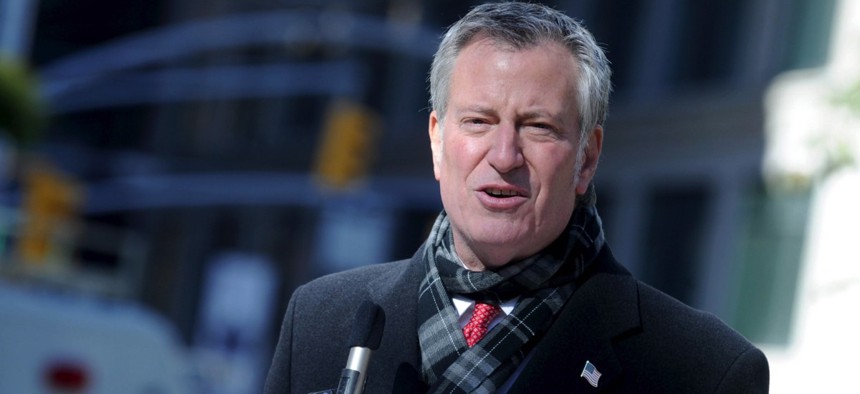New York City Defends Its Community Policing Approach

New York City Mayor Bill de Blasio AP Photo

Connecting state and local government leaders
As the Trump administration defunds the Obama-era strategy, city officials are crediting it with reducing crime to record lows.
New York City officials credited community policing for the safest November in the city’s recorded history.
The self-styled “safest big city in America” is on pace to see the lowest number of crimes committed since the 1950s, said Mayor Bill de Blasio during a Monday press conference, with overall crime down 7.7 percent, murders down 20 percent and shootings down 26 percent compared to November 2016.
Placing 2,000 more police officers on patrol over two years and providing them with new training and equipment played a part, the mayor said.
“Really, I believe most fundamentally the neighborhood policing strategy has been the leading edge of change,” de Blasio said. “And this [32nd] precinct got the [neighborhood coordination officer]s in October 2015 and has been seeing reductions in crime ever since.”
New York City’s prioritization of community policing comes in stark contrast to the Justice Department’s punitive approach, Attorney General Jeff Sessions ending the Collaborative Reform Initiative for Technical Assistance in September. The community policing program was started in 2011—at local law enforcement’s request—to provide police departments with the federal resources needed to curb use of excessive force, racial profiling and negative police-community relations.
In New York City, community policing entails assigning precincts neighborhood coordination officers available by phone or text to receive information on crimes like drug trafficking, illegal weapon possession and gang violence. NCOs develop relationships with store owners, building superintendents and youth in the community to add a “human dynamic” to policing, de Blasio said.
“No one knows a neighborhood, a street or a block better than those who live and work there every day,” said New York Police Department Commissioner James O’Neill. “These are the good people, who know who the bad people are.”
As of Nov. 30, the city saw 259 homicides, 126 of which were shootings, compared to 312 homicides by that point last year, 181 of which were shootings. There were 20 homicides in all of November, down from 25 last November.
On the whole, rapes are down 2 percent on the year, but they were down 7 percent as of August. In November, the number of monthly rapes rose from 96 to 111, a “particularly disturbing” 16 percent increase, said Dermot Shea, the NYPD’s chief of crime control strategies.
“That coincides with the news media coverage of late,” Shea said. “Very difficult to say what kind of role that plays in it.”
Law enforcement officials made clear there was no evidence the two are linked, but they hoped increased reports of sexual misconduct in the news would encourage more victims to come forward. A total of 285 reports of rape in 2017 concerned incidents from previous years, compared to 255 reports in 2016.
The NYPD has gotten more aggressive responding to calls of domestic violence, which often interplays with rape. Police now regularly check in on households where domestic violence has been previously reported to ensure they’re a visible presence.
Rape arrests have risen with rape reports, according to Shea.
“It is a force multiplier to have the people of this city constantly supporting the police with good information that leads to arrests and disrupts crime,” de Blasio said. “That is what neighborhood policing is helping to achieve.”
Dave Nyczepir is a News Editor at Government Executive’s Route Fifty and is based in Washington, D.C.

NEXT STORY: Trump Shrinks Two National Monuments in Utah





